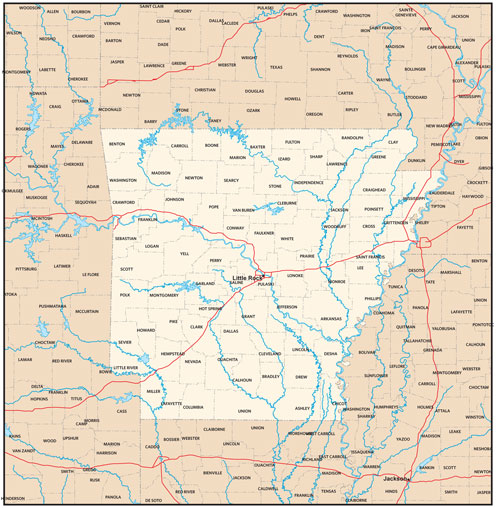Sign up for the Family Tree Newsletter Plus, you’ll receive our 10 Essential Genealogy Research Forms PDF as a special thank you!
Get Your Free Genealogy Forms
"*" indicates required fields
In what is now Arkansas, 16th-century Spanish explorers found a considerable Indian population living in agricultural settlements. Between 1673 and 1740, French explorers, trappers and traders traversed the area. By the end of the Seven Years’ War in 1763, France ceded to Spain all of Louisiana, the vast territory west of the Mississippi that included Arkansas. Later, as Napoleon prepared for retrocession of Louisiana to France, the Louisiana Purchase of 1803 made Arkansas US territory. By then, Osage, Caddo, and Quapaw Indians felt the push of Cherokee and white settlers moving into Arkansas.
Missouri and Arkansas were then part of the undefined district Upper Louisiana, and in 1805, became Louisiana Territory. For decades, Arkansas was a destination for white explorers and settlers, as well as a route for thousands of Indians forced from the Southeast to Indian Territory. The Caddo signed the last Indian land cession in Arkansas in 1835.
In 1812, Arkansas became part of Missouri Territory. Originally part of New Madrid County, Arkansas County was established in 1813. “Arkansaw” Territory, created in 1819, included most of Oklahoma as Indian lands; the present western boundary was established when Arkansas became the 25th state in 1836.
The state’s numerous rivers drain into the Mississippi and were important transportation routes in the 19th century.Many settlers came via the Mississippi and its tributaries, but swampy and flood-prone plains along rivers in eastern Arkansas limited the growth of towns there. Major towns developed farther upriver. One early road that invited settlement along its route was the Southwest Trail across Arkansas, leading into Texas.
Despite mountainous terrain in the north and west and forests statewide, settlers saw agricultural opportunity in the availability of cheap federal land or, for some, bounty land due them for military service. Before the Civil War, settlers streamed into Arkansas from neighboring states — especially Tennessee — and from Alabama, other southern states, and the Ohio Valley.
Cotton, often cultivated with slave labor, became the dominant crop on farms and plantations in the east and south. By 1860, slaves were a quarter of the state’s population. Wheat production was important in the north and west. Corn was a staple for people and livestock throughout the state.
Due largely to geography, settlement patterns and the state’s regional economies, antebellum political power rested generally in the south and east. By 1861, many Arkansans were Unionists. Secession was hotly debated. Only after the war began did Arkansas join the Confederacy. The Union army occupied northwest Arkansas during much of the Civil War. Both pro-Union and -Confederate state governments operated in the last year of the war. Hostilities included both formal military operations and guerrilla warfare.
Although the state rejoined the Union in 1868, reconstruction was difficult, with widespread poverty and discontent. Late-19th century economic development included railroads, logging and timber manufacturing. Post-Civil War decades also saw expansion of cotton farming, sharecropping and European immigration. In the early 20th century, Arkansas experienced growth in its textile, petroleum, and mining industries. But the economy remained generally rural and cotton-dominated until after World War II. By 1980, the rural population was slightly less than half the state total.
RESEARCH TIPS
- Someone reportedly born in Missouri or Louisiana during either territorial period could have been born in what is now Arkansas.
- Arkansas is a federal land state, whose land patents are searchable at http://www.glorecords.blm.gov.
- Arkansas federal censuses date from 1830.
- Learn more about Arkansas History Commission records at http://www.ark-ives.com/research/materials.asp.
CENSUS RECORDS
- Federal census population schedules: 1830, 1840, 1850, 1860, 1870, 1880, 1900, 1910, 1920, 1930
- Federal mortality schedules: 1850, 1860, 1870, 1880
- Federal slave schedules: 1850, 1860 (schedules name slaveholders but rarely name slaves)
- Territorial sheriffs’ censuses: 1823 (Arkansas County), 1829 (various counties)
GENERAL RESOURCES
- Abstracts of Arkansas Reports, January 1837 through January 1861 compiled by Joan Thurman Taunton (Arkansas Genealogical Society, 1988)
- Arkansas Families: Glimpses of Yesterday Columns from the Arkansas Gazette by Lucy Marion Reaves, edited by Desmond Walls Allen (Arkansas Research, 1995)
- Arkansas and Its People, a History, 1541-1930 edited by David Yancey Thomas (The American Historical Society, 1930)
- Arkansas Links: A Comprehensive Guide to Genealogical Research in the Natural State by Rhonda S. Norris (Morris Publishing, 1999)
- Arkansas Pensioners, 1818-1900 compiled by Dorothy E. Payne (Southern Historical Press, 1985)
- Arkansas Research Outline by the Church of Jesus Christ of Latter-day Saints (online at http://www.familysearch.org/eng/search/RG/guide/arkansas.asp)
- Arkansas Researchers’ Handbook by Claudia Wagoner (Research Plus, 1986)
- Biographical and Historical Memoirs of Eastern Arkansas (The Goodspeed Publishing Co., 1890)
- The By-Name Index to the Centennial History of Arkansas compiled and edited by Lewis E. Roberts (L.E. Roberts, 1991)
- Early Days in Arkansas by William F. Pope (F.W. Allsopp, 1895)
- From Slavery to Uncertain Freedom: The Freedmen’s Bureau in Arkansas, 1865-1869 by Randy Finley (University of Arkansas Press, 1996)
- Genealogist’s Guide to Arkansas Courthouse Research by Jack Damon Ruple, Sr. (J.D. Ruple, 1989)
- History of the Arkansas Press for a Hundred Years and More by Frederick William Allsopp (Parke-Harper Publishing, 1922)
- Lest We Forget, or, Character Gems Gleaned from South Arkansas by J.H. Riggin and W.F. Evans (Southern Historical Press, 1978)
- Pioneers and Makers of Arkansas by Josiah Hazen Shinn (Genealogical Publishing Co., 1967)
- They Sought a Land: A Settlement in the Arkansas River Valley, 1840-1870 by William Oates Ragsdale (University of Arkansas Press, 1997)
- Union List of Arkansas Newspapers, 1819-1942, prepared by Historical Records Survey, Works Projects Administration (Historical Records Survey, 1942)
Return to the main Arkansas page
From the Family Tree Sourcebook
Also available: the State Research Guide Book, State Research Guides CD and The Researcher’s Guide to American Genealogy.
ADVERTISEMENT

